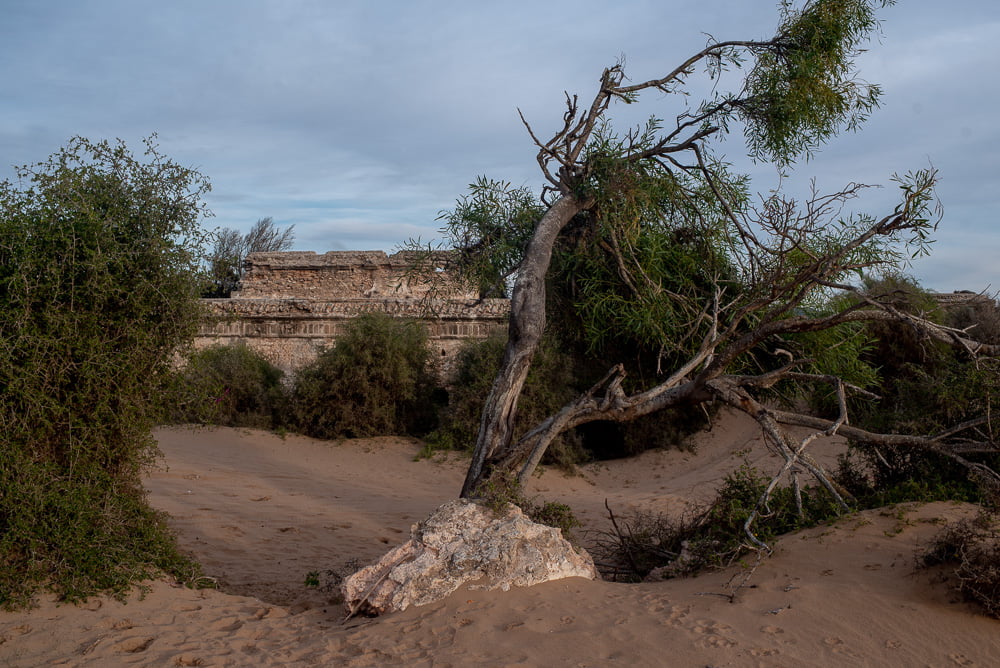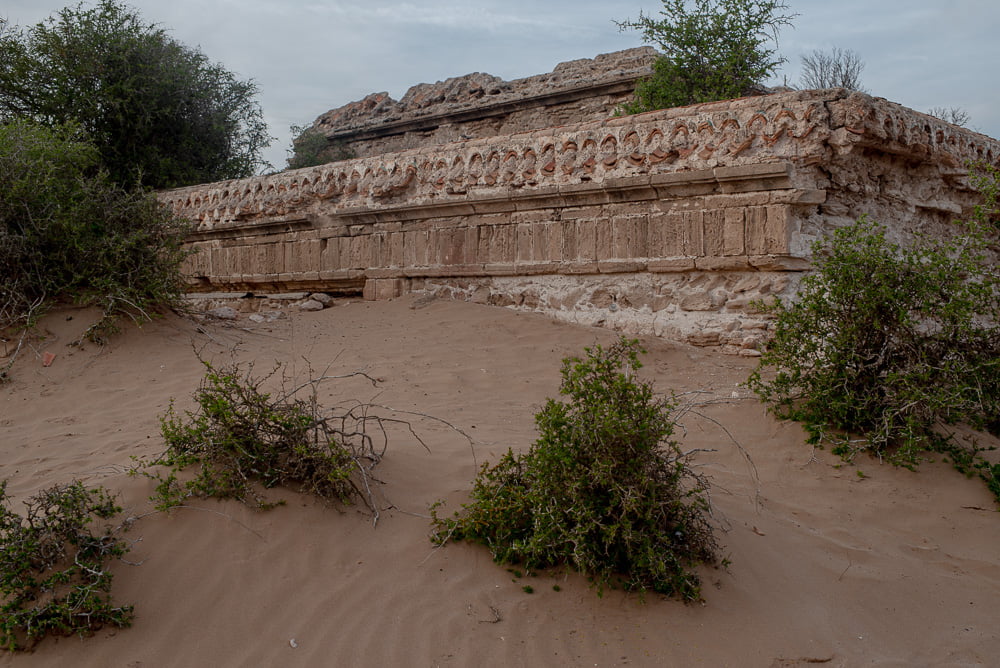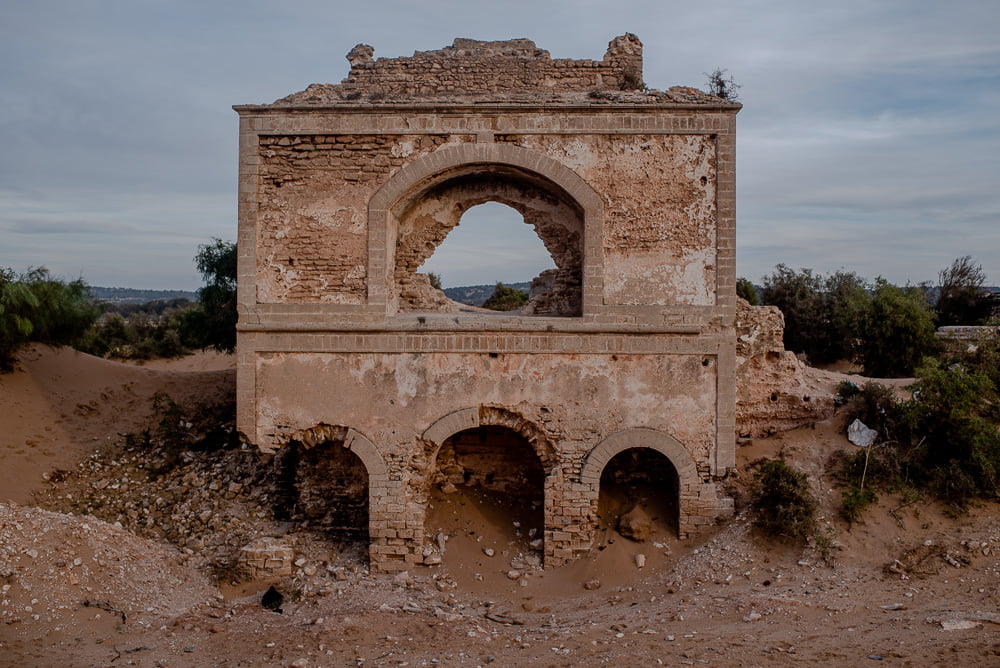Dar Soltane ( the Sultan’s House built in the late 18th century ) is an impressive ruin in the sand dunes south of Essaouira. It was once the home of the sultan of Morocco, Sidi Mohamed III Ben Abdallah al Qatib.
I initially considered including some of the photographs below in a recent blog post ( here ) regarding the legend of Jimi Hendrix. Legend incorrectly suggests he was inspired by Dar Soltane to write his song Castles Made of Sand . However because of the interesting history of the palace in its own right I decided to document the photographs in a separate posting.
The ruins are very easily reached by taking a bus from Essaouira to Diabat, then walking along the sandy road which leads directly to them. I approached by walking along the beach from Essaouira, past the horses and camel rides, over dunes and a small lagoon and as far as a little lighthouse looking out over the ocean. Then I cut inland to the ruins which had been visible for a considerable time.
First impressions, as the great walls struggle out of the suffocating sand and thickets of bushes and trees, are that the ruins are extremely evocative and must have been magnificent when first constructed. I have managed to find something of a history online which I have translated and reproduced below together with some photographs.
The following account of the history of Dar Soltane has been taken from here and here , the latter link has many photographs and has more information. The remainder of this posting is translated from these sources.
Dar Soltane ( The Sultan’s House ) is also known as the White House. Built in 1780, it was the former residence of the king, but is now half buried under the sands near the village of Diabet. When first built it was a very beautiful palace, decorated and sculpted with arabesques, its walls were covered with different types of zeligige, and its floor with quality marble. A beautiful koubba overlooked the building and provided a panoramic view of the entire region.
It was built by a rich merchant from the Dutch or English makhzen ( ruling classes of Morocco ) called Hoban. He gifted it to Sultan Sidi Mohamed Ben Abdallah al Qatib, who made it his summer residence. The palace, now in ruins and buried by the sands, was once magical and beautiful.
This palace, made up of 5 buildings, was fully European-style and had glass windows, fitted by Dutch artisans, as well as gilded mirrors; its windows were equipped with crystal, fireplaces had been built with marble and it was surrounded with a real forest of nice-smelling tamarisks, decorated with ponds. Of Andalusian style, it distinguished itself by its beautiful ceilings in sculptured and painted woodwork. Walls and gardens overhung the course of the river Ksob which ran beside it.
Important people visited this building: ambassadors, consuls such as Barisien and Höst; men of science like Ali Bey-el-Abassi, merchants and so many others. It then became the residence of Moulay Abderrahmane, Khalifa of the King to Mogador and governor of the city at the time. When this prince became king (1822-1858), the palace served as a temporary residence for the high dignitaries of the makhzen ( Moroccan ruling classes ).
Over the years this magnificent building somehow became abandoned. For a long time this palace which was under the protection of the inhabitants of Diabet was gradually attacked by vandals and winds of sand, and fell into oblivion.
Sidi Mohamed Ben Abdallah al Qatib was sultan of Morocco (1710-1790). He was born around 1710 in Meknes and died in Fes in 1790. He was an itinerant king, he did not choose a particular capital although he had himself built a large palace in Rabat. It was he who founded Essaouira and maintains good relations with all Eastern and Western countries; in particular under his kingship Morocco was the very first country to recognise the United States as an independent nation; something that President Barak Obama recognised in his historic speech at Cairo.
And let us not also forget that it was the Sultanwho helped the Emir Abdelkader of Algeria who was fighting against the French then in full conquest of Algeria. In short this is a small description of the founder of Essaouira and of this palace which you can see in these photos. I hope that our officials of the Ministry of Culture and others take things in hand in order to save this example of national heritage and through saving this building also the history of the Alaouite dynasty.
Regarding the legend of Jimi Hendrix drawing inspiration from the ruins, and other associated assertions, the same website suggests the following :
Beware of sites that do not verify the information they broadcast. Sometimes some sites go a little too far. Here’s an example of this exaggeration :
Jimi Hendrix, a famous American rock guitarist in the psychedelic era, is reputed to have wanted to buy the village of Diabat which is south of the city. The governor objected wisely, but the musician nevertheless bought the sultan’s ruined palace. This house soon turned into a refuge for hippies from everywhere. Jimi stayed there maybe once or twice, but never for long. Finally, following several murders linked to drug trafficking, the police intervened and dispersed Jimi Hendrix’s followers to other cities in other countries
Today, Hendrix’s Castle is invaded by the dunes and buried under the brushwood This archaeological treasure buried under the sands is still the property of the Moroccan state and will surely remain so for eternity, the land title in support. Hopefully one day it will be cleared and rehabilitated for the enjoyment of visitors!









